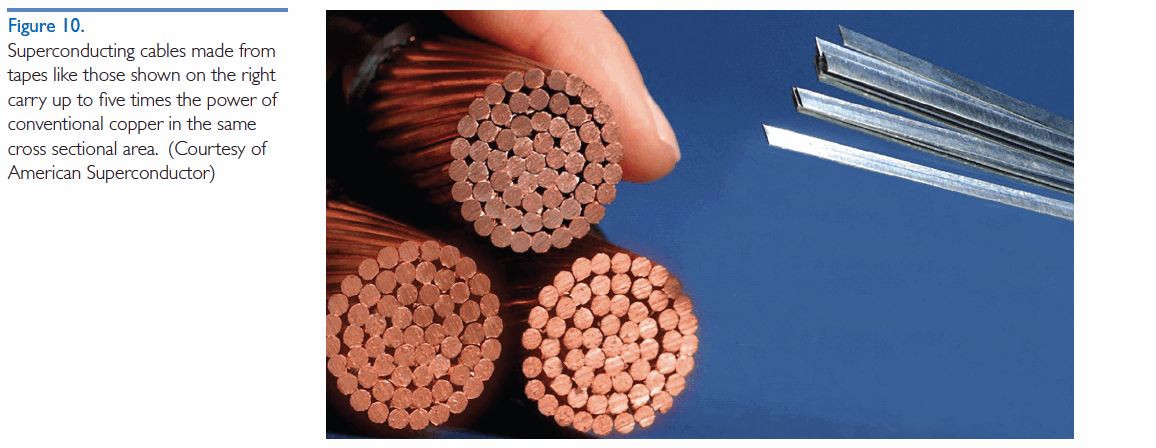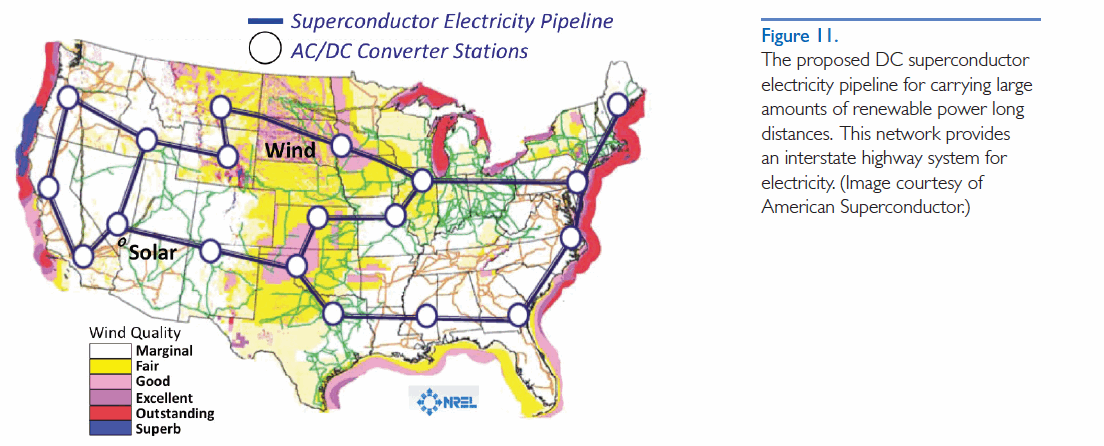AMERICAN PHYSICAL SOCIETY
Executive Summary
The United States has ample renewable energy resources. Land-based wind, the most readily available for development, totals more than 8000 GW of potential capacity. The capacity of concentrating solar power is nearly 7,000 GW in seven southwestern states. The generation potential of photovoltaics is limited only by the land area devoted to it, 100–250 GW/100 km2 in the United States. To illustrate energy capacity vs. projected demand, the US generated electric power at an average rate of approximately 450 GW in 2009, with peaks over 1000 GW during the summer months. By 2035, electricity demand is projected to rise 30%.
To date, 30 states, plus the District of Columbia have established Renewable Portfolio Standards (RPS) to require that a minimum share of electrical generation is produced by renewable sources. In addition to state policies, federal policymakers have put forward proposals to establish a national RPS, making the need for technological developments more urgent.
However, developing renewable resources presents a new set of technological challenges not previously faced by the grid: the location of renewable resources far from population centers, and the variability of renewable generation. Although small penetrations of renewable generation on the grid can be smoothly integrated, accommodating more than approximately 30% electricity generation from these renewable sources will require new approaches to extending and operating the grid.
The variability of renewable resources, due to characteristic weather fluctuations, introduces uncertainty in generation output on the scale of seconds, hours and days. These uncertainties, affect up to 70% of daytime solar capacity due to passing clouds and 100% of wind capacity on calm days for individual generation assets. Although aggregation over large areas mitigates the variability of individual assets, there remain uncertainties in renewable generation that are greater than the relatively predictable uncertainties of a few percent in demand that the grid deals with regularly.
Greater uncertainty and variability can be dealt with by switching in fast-acting conventional reserves as needed on the basis of weather forecasts on a minute-by-minute and hourly basis; by installing large scale storage on the grid or; by long distance transmission of renewable electricity enabling access to larger pools of resources in order to balance regional and local excesses or deficits. At present, renewable variability is handled almost exclusively by ramping conventional reserves up or down on the basis of forecasts. However, as renewable penetration grows, storage and transmission will likely become more cost effective and necessary.
Forecasting
The high variability of renewable generation, up to 100% of capacity, makes forecasting critical for maintaining the reliability of the grid. Improving the accuracy and the confidence level of forecasts is critical to the goal of reducing the conventional reserve capacity, and will result in substantial savings in capital and operating costs.
The variability of renewable energy is easily accommodated when demand and renewable supply are matched—both rising and falling together. However when demand and renewable supply move in opposite directions, the cost of accommodation can rise significantly. For example, if the wind blows strongly overnight when demand is low (as is often the case), the renewable generation can be used only if conventional base-load generation such as coal or nuclear is curtailed, an expensive and inefficient option that may cause significant reliability issues. Alternatively, on calm days when there is no wind power, the late-afternoon peak demand must be met entirely by conventional generation resources, requiring reserves that effectively duplicate the renewable capacity. Reducing the cost of dealing with these two cases is a major challenge facing renewable integration.
…
Energy Storage
As renewable generation grows it will ultimately overwhelm the ability of conventional resources to compensate renewable variability, and require the capture of electricity generated by wind, solar and other renewables for later use. Transmission level energy storage options include pumped hydroelectric, compressed air electric storage, and flywheels. Distribution level options include: conventional batteries, electrochemical flow batteries, and superconducting magnetic energy storage (SMES). Batteries also might be integrated with individual or small clusters of wind turbines and solar panels in generation farms to mitigate fluctuations and power quality issues. Although grid storage requires high capacity and long lifetimes, it often allows a stationary location and housing in a controlled environment, very different from the conditions for portable or automotive storage.
Currently, energy storage for grid applications lacks sufficient regulatory history. Energy storage on a utility-scale basis is very uncommon and, except for pumped hydroelectric storage, is relegated to pilot projects or site-specific projects. Some states such as New York categorize storage as “generation,” and hence forbid transmission utilities from owning it. In addition, utilities do not know how investment in energy storage technologies will be treated, how costs will be recovered, or whether energy storage technologies will be allowed in a particular regulatory environment.
…
Long Distance Transmission
Renewable sources are typically distributed over large areas in the upper central and southwestern US, including the Dakotas, Iowa, Minnesota and Montana, and far from demand centers east of the Mississippi and on the West Coast. New large area collection strategies and new long distance transmission capability are required to deliver large amounts of power thousand miles or more across the country. This long distance transmission challenge is exacerbated by a historically low investment in transmission generally: from 1988–1998 demand grew by 30%, while transmission grew by only 15%; from 1999–2009 demand grew by 20% and transmission by only 3%. In denser population areas there are community concerns around new right-of-way for above ground transmission towers. The “not in my backyard” arguments are costly to overcome and can delay or stop above-ground transmission construction.
While high voltage DC is the preferred transmission mode for long distances, the drawbacks of single terminal origin and termination, costly AC-DC-AC conversion, and the decade or more typically needed for approval for long lines create problems for renewable electricity transmission. Superconductivity provides an new alternative to conventional high voltage DC transmission. Superconducting DC lines operate at zero resistance, eliminating electrical losses for any transmission length, and operate at lower voltages, simplifying AC-DC conversion and enabling wide-area collection strategies. Superconducting DC transmission lines carrying 10 GW of power 1600 km can be integrated into the Eastern and Western grids in the US while maintaining transient and short-term voltage stability.
…
Business Case
Utility renewable energy investments are typically assessed from regulatory, project finance, and technical perspectives. The regulatory assessment focuses on ensuring utility compliance with renewable portfolio standards (RPS) and that costs are kept within prudent limits. The project finance view looks at the merits of the investment within discrete boundaries of the funding and cash flows exclusive to the project under review. The technical assessment evaluates the engineering and operational risks of the project and specific technologies involved.
While these conventional views are important for investors, utilities, regulators and ratepayers, they do not fully capture the set of benefits that a renewable energy investment can deliver beyond the boundaries of a given project, such as the physical benefits of transmission and storage and the organizational benefit of developing an integrated picture of the grid. Inclusion of these additional benefits in an expanded business case will enhance the profile of the renewables investment, and more importantly, begin to recognize the synergies inherent in the integration of renewables with the grid.
…
Download full version (PDF): Integrating Renewable Electricity on the Grid
About American Physical Society
www.aps.org
“The American Physical Society strives to: be the leading voice for physics and an authoritative source of physics information for the advancement of physics and the benefit of humanity; provide effective programs in support of the physics community and the conduct of physics; collaborate with national scientific societies for the advancement of science, science education and the science community; cooperate with international physics societies to promote physics, to support physicists worldwide and to foster international collaboration; promote an active, engaged and diverse membership, and support the activities of its units and members.”
Tags: American Physical Society, APS, Department of Energy, Federal Energy Regulatory Commission, FERC, National Center for Atmospheric Research, National Oceanic and Atmospheric Administration, National Weather Service, NCAR, NERC, NOAA, North American Electric Reliability Corporation, NWS, Solar, Wind








 RSS Feed
RSS Feed